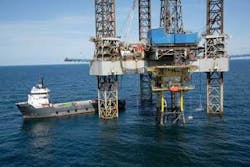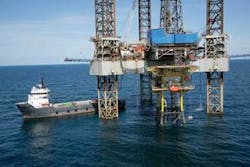OFFSHORE EUROPE
Jeremy Beckman, London
null
Cavendish building up steam
RWE Dea expects to add two more wells to its Cavendish gas field development, which came on stream in the UK southern North Sea in July. This is also the German company’s first operated project in the UK sector.
According to managing director in London Christoph Schlichter, the platform has six well slots, allowing for tie-ins of future discoveries in the area. Cavendish’s produced gas has to travel 46 km (28.6 mi) through a 10-in. (25.4-cm) steel pipeline to ConocoPhillips’ Murdoch compression platform. It was not an easy project, he explained at a recent briefing, due to a combination of high activity levels throughout the UKCS constraining contractor availability, and plunging gas prices on the UK mainland. Also, the field’s 3.5-4.5% CO2 content meant that the gas had to pass through a specially devised subsea cooler before entering the pipeline - a first for the southern sector, he claimed.
One of the nearby prospects is Kepler, but CO2 levels here are even higher, which might necessitate construction of a CO2 removal plant. That could kill the project, he maintained, unless the government decided to reverse its recent corporation tax rise.
RWE Dea also may look to drill a well next year on the Topaz structure, which could lead to a subsea tieback to Tullow’s Schooner complex. Farther north, the company is a partner in Devenick, a much larger wet-gas field. Operator BP recently shelved a planned development, again due largely to gas prices, but Schlichter hoped the project would go forward again during 2009-10.
Troll gas expansion ruled out
Norway’s government has vetoed proposals to increase gas production from the Troll field, citing concerns over the impact on oil extraction. Operator StatoilHydro has reacted by withdrawing from another project to increase the country’s gas export capacity.
The Ministry of Petroleum and Energy is mindful of the decline in Norwegian oil production. It forecasts an average of 2.6 MMb/d across the shelf this year, the lowest since 1994, and expects output to slip further to around 2.5 MMb/d over the next two years. At the same time, it points out that the nation’s gas exports are soaring, thanks to supplies from the newly onstream Ormen Lange and Snøhvit projects. It foresees total gas sales of 88 bcm (3.1 tcf) this year rising to 108 bcm (3.8 tcf) in 2008, with further growth thereafter.
StatoilHydro planned to lift gas output from Troll by 25 MMcm/d (883 MMcf/d) via increased reservoir drawdown. However, studies by the Norwegian Petroleum Directorate found that up to 65 MMbbl of oil could be lost as a result, and potentially up to 600 MMbbl over the field’s life. The Ministry told the licensees it would therefore not approve the development plan, which had not been finalized.
The operator did not comment on these findings, but said it would recommend to its partners that work on Troll Future Development be discontinued. It also said it would pull out of the related Gas Network Expansion (GNE) project in its present form, a decision supported by the GNE coordinator Gassco.
The GNE team had proposed expanding capacity at the processing terminal in Kollsnes, northwest of Bergen, which receives Troll’s gas, and installing a new export pipeline between this facility and a landfall in western Europe. The pipeline could also have tied in supplies from other fields in the Norwegian Sea and the northern North Sea. Gassco said it would continue studies into future transportation options for these regions.
Independents join forces
Pertra and DNO have agreed to merge, forming Norway’s second largest indigenous operator after StatoilHydro. The new organization, to be known as Det Norske Oljeselskap ASA, will operate 17 licenses in the Norwegian sector, and plans to drill 20 operated wells over the next three years. That level of activity, the partners claim, will be on par with previous programs by Norsk Hydro and Saga Petroleum.
In late September, Pertra proved oil in Paleocene sandstones while drilling the Storskrymten prospect in North Sea license Pl 337. The location of the well, drilled by the jackupMaersk Giant, is 16 km (9.95 mi) northwest of the Varg field. Pertra then opted to deepen the well to 3,300 m (10,826 ft) to test a Jurassic/Triassic prospect named Grytkollen.
Another Norwegian operator, Lundin Petroleum, has made a potentially much larger oil discovery on the Luno prospect, 28 km (17.4 mi) east of StatoilHydro’s Gudrun find, again in the North Sea. The well, drilled in 108 m (32.92 m) of water by the semisubmersibleBredford Dolphin, found light oil in a clastic (sandstone) Jurassic-age reservoir. Lundin puts recoverable reserves in the range 65-190 MMboe, with further potential in the Triassic section that was penetrated by the same well. The partners are looking to bring in another rig swiftly to help evaluate the reservoir and its extension.
NAM puts fields up for sale
The Shell/ExxonMobil joint venture ShellExpro has been slimming down its UK North Sea operations, putting numerous tail-end fields up for sale. Now NAM, their counterpart in the Netherlands, has been doing the same, offering licenses containing five producing Dutch L-block gas fields and the F3-FB oil and gas field. The company believes third parties may be able to extract more value.
All the fields and their facilities are interconnected by the Nogat trunkline, which transports the gas to the NAM-operated processing terminal in Den Helder. NAM also plans to divest its share in Nogat. However, the company denies a large-scale retreat form the Dutch sector, pointing to its current investment of several hundred million dollars to further develop its L9 block assets.
Ireland tables Porcupine acreage
Ireland’s government is opening more deepwater blocks in its western waters for exploration. The area on offer comprises around 63,500 sq km (24,517 sq mi) in the Porcupine basin. Minister Eamon Ryan also announced a new profit resource tax would be imposed on any finds arising from this round, scaled according to commerciality. The most profitable fields could incur tax of up to 40%, a 15% increase over previous terms.
Most of the country’s recent exploration action has centered on the gas-prone Celtic Sea off the south coast. However, Providence Resources may have unearthed a substantial oil accumulation in the Hook Head structure, discovered by Marathon in the 1970s.
The semisubPetrolia drilled an appraisal well late this summer into the structure’s crest, 60 km (37 mi) offshore, encountering 30° API crude with associated gas. The well intersected a 484-ft (148-m) gross interval in the main target zone, and three more prospective zones were logged as being hydrocarbon-bearing. Providence plans to return next year for appraisal and possible development drilling, assuming a rig can be secured.

